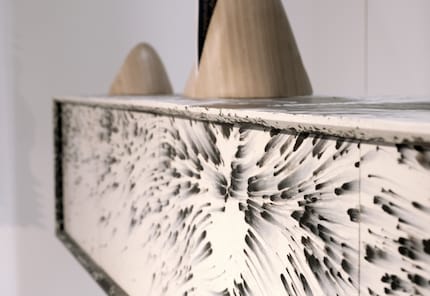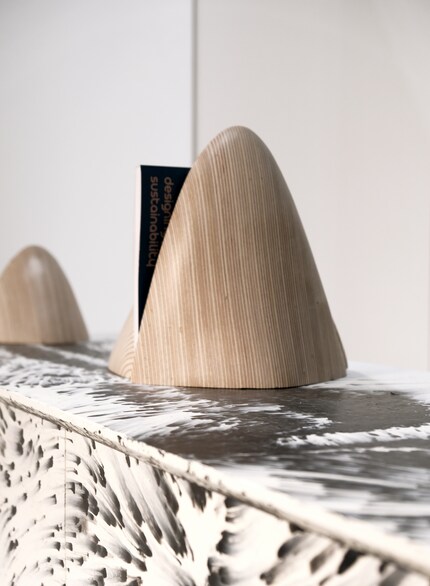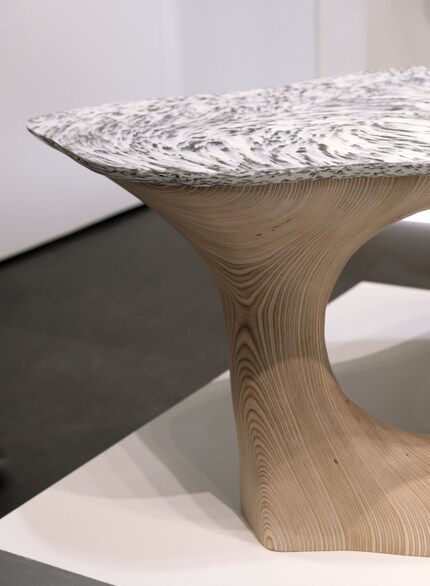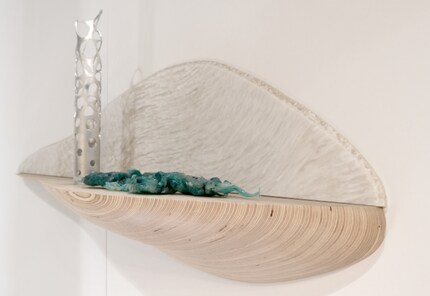What waste material do you think the sideboard is made of?
Submit your tip - you'll find the solution right below.
- Ceramics10%
- Plastic54%
- Epoxy resin37%
The competition has ended.
For this sideboard, designer Cyryl Zakrzewski has combined conical wooden elements with a recycled material. Join the guessing game to find out what it is.
Polish artist and sculptor Cyryl Zakrzewski experiments with advanced technologies. He recognises the potential of things that most people probably throw in the bin. That’s why he wanted to show a recycled material for furniture or interior design in a new light. Can you guess what, for example, the panels of the «Nexus» sideboard from the «Continuum» collection are made of by looking at the following features? You’ll find the solution at the bottom.

The material for the «Nexus» panels can often be found in nature – in Europe, but also in India, China or South Africa. If you consider and acquire this material as an economic good, you can process it with the help of the right machines. It’s only if you want to extract it that you have to do it yourself. Once that’s done, it can be cleaned and cut by a machine. Because it keeps moisture out, it’s used in industry or for interior fittings to clad facades or make kitchen countertops, for example.
Submit your tip - you'll find the solution right below.
The competition has ended.
From afar, the «Nexus» panels resemble natural stone. But they’re made of plastic and were created by Nowymodel Foundation and the company Boomplastic, which produces materials and products from recycled plastic. Cyryl draws the design on the computer using 3D programs. With the help of Boomplastic, he melts and compresses the waste material several times, creating layers that resemble the natural structure stone. The designer then uses a CNC machine to cut the individual parts, which he then assembles by hand like you would ordinary cabinet panels. The organic shapes he uses for the wooden elements, which are also handmade, are anything but ordinary. They turn the sideboard into sculpture.


With the Continuum furniture, the designer wants to showcase what you can create from plastic if you’re willing to look at it with a pair of fresh eyes. Instead of labelling it as a cheap, inferior material, he sees the advantage in its properties: plastic is durable, water-repellent and can add a touch of luxury by means of visual effects. The only crux? It’s hard to source the material once it’s been discarded, he explains in an interview with «Design Alive»: «It’s a tedious affair, as you have to extract it manually because there aren’t any machines that can do it for you.» At a later stage, the material also needs to be washed and sorted, as not all types of plastic are recyclable. Boomplastic is one of the few companies dedicated to the lengthy process, he explains.

The effort to source the mix of plastics, as well as the manual labour that goes into making furniture like this means it’s an expensive luxury item – and, unfortunately unavailable from our online store. «For the time being, it’s an art project to raise awareness,» says Cyryl. He uses his design project as an excuse to draw attention to the global plastic waste problem. So for the time being, these decorative objects will remain in a gallery. Despite them being handy.
This is the fifth instalment of the «Guess what?» series, in which you can use my clues to guess a design piece’s «secret ingredient». Here are some other instalments from the series:
Header photo: Pia Seidel
Like a cheerleader, I love celebrating good design and bringing you closer to everything furniture- and interior design- related. I regularly curate simple yet sophisticated interior ideas, report on trends and interview creative minds about their work.
Interesting facts about products, behind-the-scenes looks at manufacturers and deep-dives on interesting people.
Show all